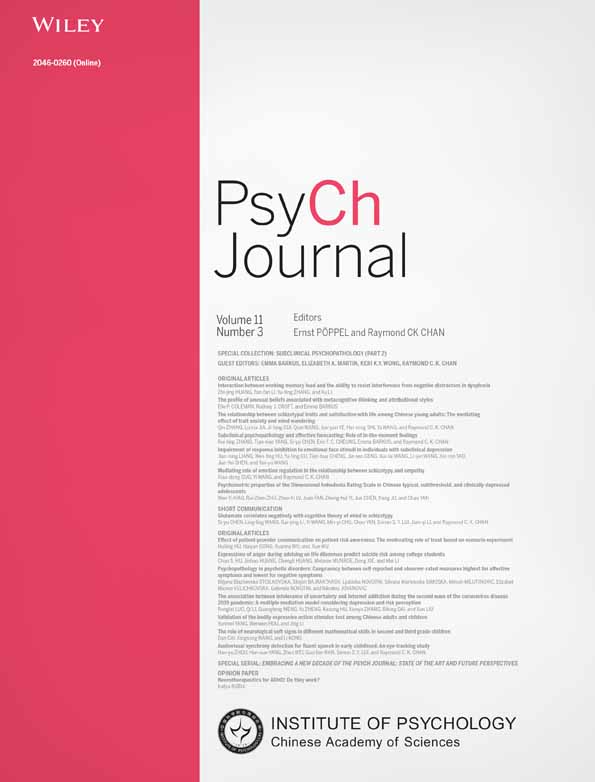Glutamate correlates negatively with cognitive theory of mind in schizotypy
Si-yu Chen
Neuropsychology and Applied Cognitive Neuroscience Laboratory, CAS Key Laboratory of Mental Health, Institute of Psychology, Beijing, China
Department of Psychology, University of Chinese Academy of Sciences, Beijing, China
Search for more papers by this authorLing-ling Wang
Neuropsychology and Applied Cognitive Neuroscience Laboratory, CAS Key Laboratory of Mental Health, Institute of Psychology, Beijing, China
Department of Psychology, University of Chinese Academy of Sciences, Beijing, China
Search for more papers by this authorGai-ying Li
Shanghai Key Laboratory of Magnetic Resonance, School of Physics and Electronic Science, East China Normal University, Shanghai, China
Search for more papers by this authorYi Wang
Neuropsychology and Applied Cognitive Neuroscience Laboratory, CAS Key Laboratory of Mental Health, Institute of Psychology, Beijing, China
Department of Psychology, University of Chinese Academy of Sciences, Beijing, China
Search for more papers by this authorMin-yi Chu
Shanghai Mental Health Center, Shanghai Jiao Tong University School of Medicine, Shanghai, China
Search for more papers by this authorChao Yan
Key Laboratory of Brain Functional Genomics (MOE&STCSM), Shanghai Changning-ECNU Mental Health Center, School of Psychology and Cognitive Science, East China Normal University, Shanghai, China
Search for more papers by this authorSimon S. Y. Lui
Department of Psychiatry, The University of Hong Kong, Hong Kong SAR, China
Search for more papers by this authorJian-qi Li
Shanghai Key Laboratory of Magnetic Resonance, School of Physics and Electronic Science, East China Normal University, Shanghai, China
Search for more papers by this authorCorresponding Author
Raymond C. K. Chan
Neuropsychology and Applied Cognitive Neuroscience Laboratory, CAS Key Laboratory of Mental Health, Institute of Psychology, Beijing, China
Department of Psychology, University of Chinese Academy of Sciences, Beijing, China
Correspondence
Professor Raymond C. K. Chan, Institute of Psychology, Chinese Academy of Sciences, 16 Lincui Road, Beijing, 100101, China.
Email: [email protected]
Search for more papers by this authorSi-yu Chen
Neuropsychology and Applied Cognitive Neuroscience Laboratory, CAS Key Laboratory of Mental Health, Institute of Psychology, Beijing, China
Department of Psychology, University of Chinese Academy of Sciences, Beijing, China
Search for more papers by this authorLing-ling Wang
Neuropsychology and Applied Cognitive Neuroscience Laboratory, CAS Key Laboratory of Mental Health, Institute of Psychology, Beijing, China
Department of Psychology, University of Chinese Academy of Sciences, Beijing, China
Search for more papers by this authorGai-ying Li
Shanghai Key Laboratory of Magnetic Resonance, School of Physics and Electronic Science, East China Normal University, Shanghai, China
Search for more papers by this authorYi Wang
Neuropsychology and Applied Cognitive Neuroscience Laboratory, CAS Key Laboratory of Mental Health, Institute of Psychology, Beijing, China
Department of Psychology, University of Chinese Academy of Sciences, Beijing, China
Search for more papers by this authorMin-yi Chu
Shanghai Mental Health Center, Shanghai Jiao Tong University School of Medicine, Shanghai, China
Search for more papers by this authorChao Yan
Key Laboratory of Brain Functional Genomics (MOE&STCSM), Shanghai Changning-ECNU Mental Health Center, School of Psychology and Cognitive Science, East China Normal University, Shanghai, China
Search for more papers by this authorSimon S. Y. Lui
Department of Psychiatry, The University of Hong Kong, Hong Kong SAR, China
Search for more papers by this authorJian-qi Li
Shanghai Key Laboratory of Magnetic Resonance, School of Physics and Electronic Science, East China Normal University, Shanghai, China
Search for more papers by this authorCorresponding Author
Raymond C. K. Chan
Neuropsychology and Applied Cognitive Neuroscience Laboratory, CAS Key Laboratory of Mental Health, Institute of Psychology, Beijing, China
Department of Psychology, University of Chinese Academy of Sciences, Beijing, China
Correspondence
Professor Raymond C. K. Chan, Institute of Psychology, Chinese Academy of Sciences, 16 Lincui Road, Beijing, 100101, China.
Email: [email protected]
Search for more papers by this authorFunding information: CAS Key Laboratory of Mental Health, Institute of Psychology; The National Key Research and Development Programme, Grant/Award Number: 2016YFC0906402; The Philip K. H. Wong Foundation
Abstract
This study showed a negative correlation between the glutamate level in the anterior cingulate cortex and cognitive theory of mind in individuals with high level of schizotypy but not in non-schizotypy individuals.
DISCLOSURE OF CONFLICT OF INTEREST
None to declare.
REFERENCES
- Chan, R. C. K., Wang, Y., Yan, C., Zhao, Q., McGrath, J., Hsi, X. L., & Stone, W. S. (2012). A study of trait anhedonia in non-clinical Chinese samples: Evidence from the chapman scales for physical and social anhedonia. PLoS One, 7(4), e34275. https://doi.org/10.1371/journal.pone.0034275
- Kronbichler, L., Tschernegg, M., Martin, A. I., Schurz, M., & Kronbichler, M. (2017). Abnormal brain activation during theory of mind tasks in schizophrenia: A meta-analysis. Schizophrenia Bulletin, 43(6), 1240–1250. https://doi.org/10.1093/schbul/sbx073
- Kwapil, T. R., & Barrantes-Vidal, N. (2015). Schizotypy: Looking back and moving forward. Schizophrenia Bulletin, 41, S366–S373. https://doi.org/10.1093/schbul/sbu186
- Liang, Y., Yang, H., Ma, Y., Lui, S. S. Y., Cheung, E. F. C., Wang, Y., & Chan, R. C. K. (2019). Validation and extension of the questionnaire of cognitive and affective empathy in the Chinese setting. Psych Journal, 8(4), 439–448. https://doi.org/10.1002/pchj.281
- Merritt, K., McGuire, P. K., Egerton, A., Aleman, A., Block, W., Bloemen, O. J., Borgan, F., Bustillo, J. R., Capizzano, A. A., Coughlin, J. M., & De la Fuente-Sandoval, C. (2021). Association of age, antipsychotic medication, and symptom severity in schizophrenia with proton magnetic resonance spectroscopy brain glutamate level a mega-analysis of individual participant-level data. JAMA Psychiatry, 78(6), 667–681. https://doi.org/10.1001/jamapsychiatry.2021.0380
- Reddy-Thootkur, M., Kraguljac, N. V., & Lahti, A. C. (2020). The role of glutamate and GABA in cognitive dysfunction in schizophrenia and mood disorders—A systematic review of magnetic resonance spectroscopy studies. Schizophrenia Research. https://doi.org/10.1016/j.schres.2020.02.001
- Shamay-Tsoory, S. G., & Aharon-Peretz, J. (2007). Dissociable prefrontal networks for cognitive and affective theory of mind: A lesion study. Neuropsychologia, 45(13), 3054–3067. https://doi.org/10.1016/j.neuropsychologia.2007.05.021
- Stone, J. M., Day, F., Tsagaraki, H., Valli, I., McLean, M. A., Lythgoe, D. J., O'Gorman, R. L., Barker, G. J., McGuire, P. K., & OASIS. (2009). Glutamate dysfunction in people with prodromal symptoms of psychosis: Relationship to gray matter volume. Biological Psychiatry, 66(6), 533–539. https://doi.org/10.1016/j.biopsych.2009.05.006




